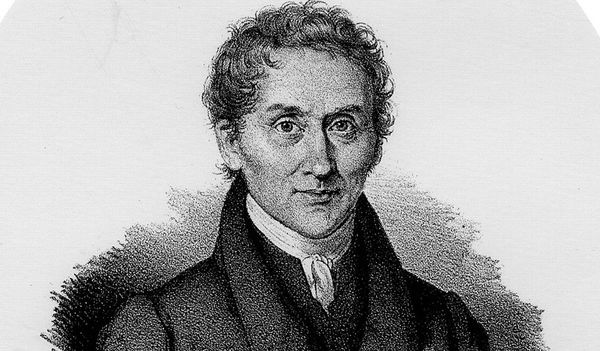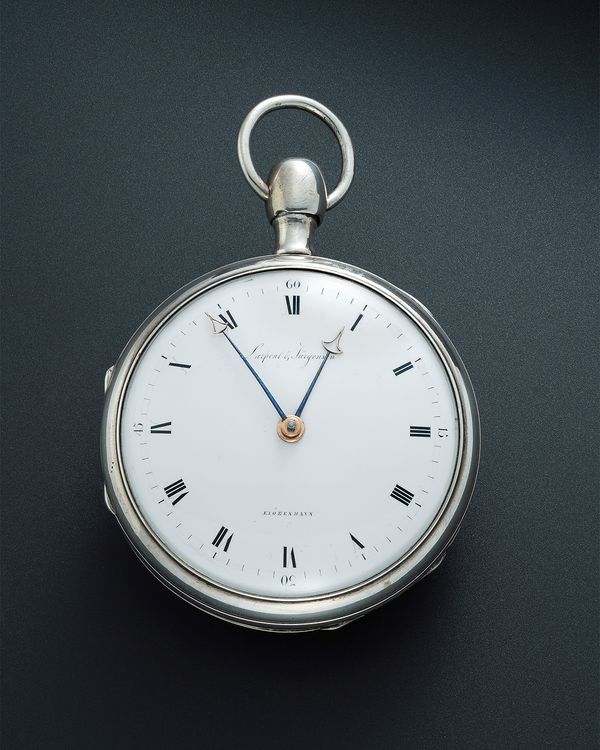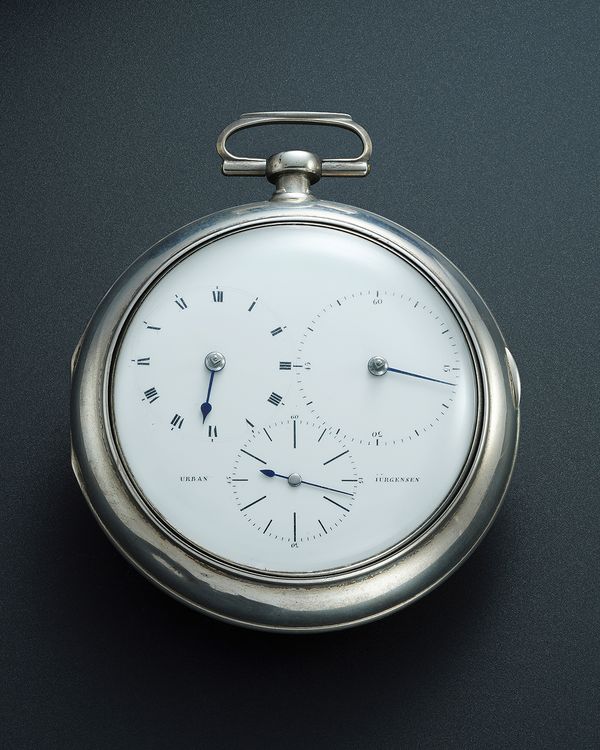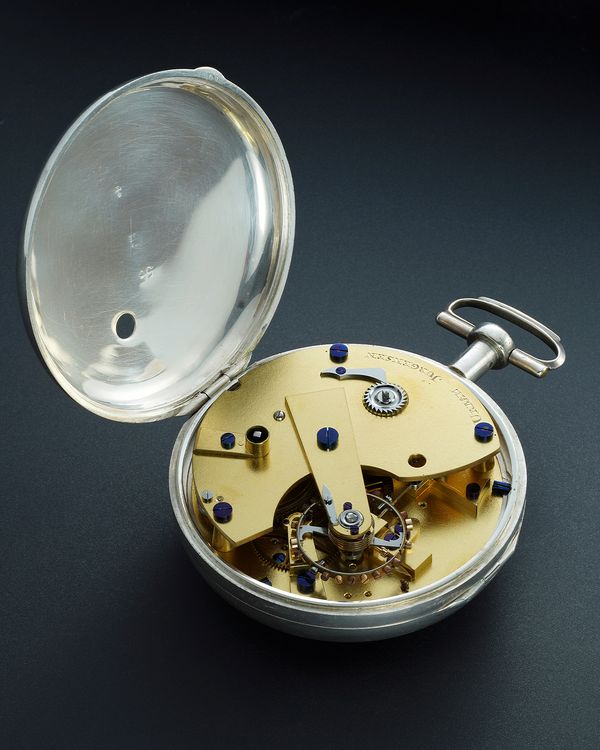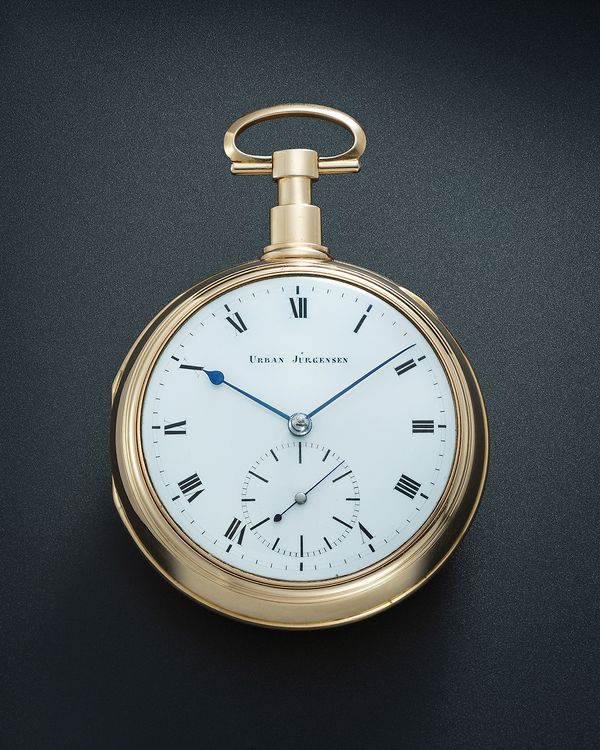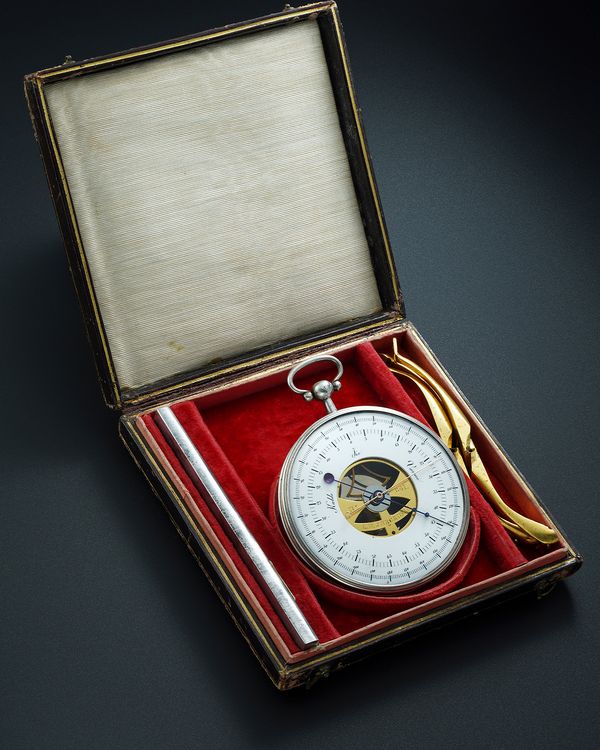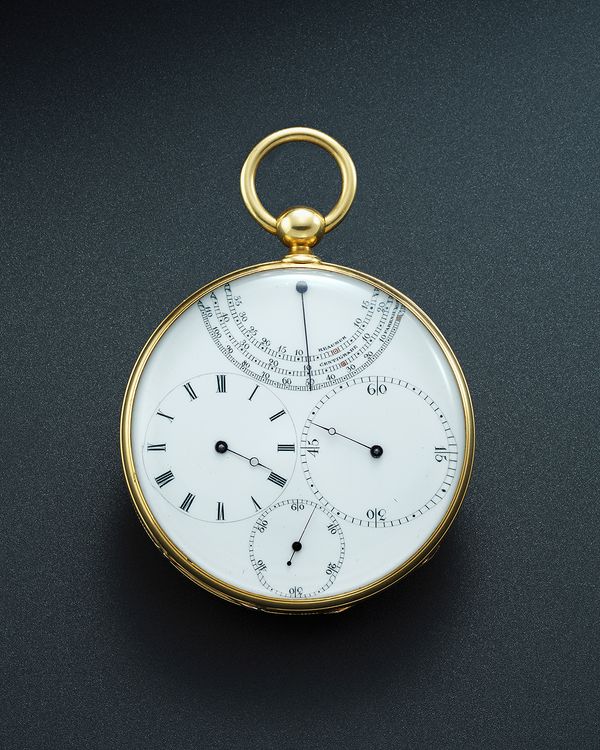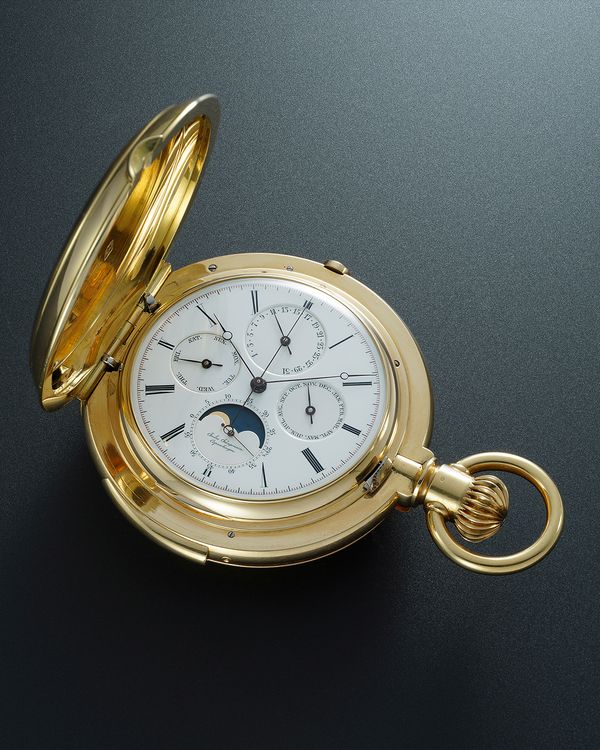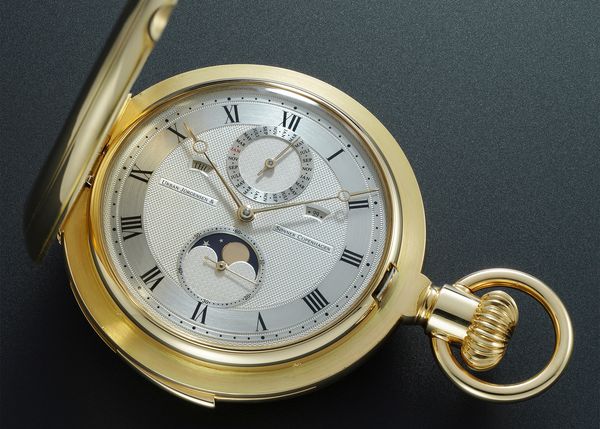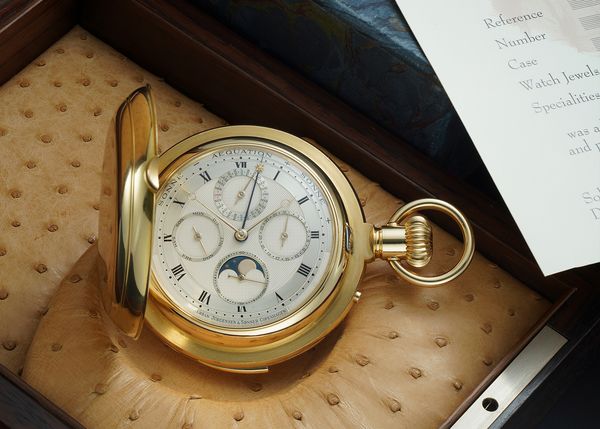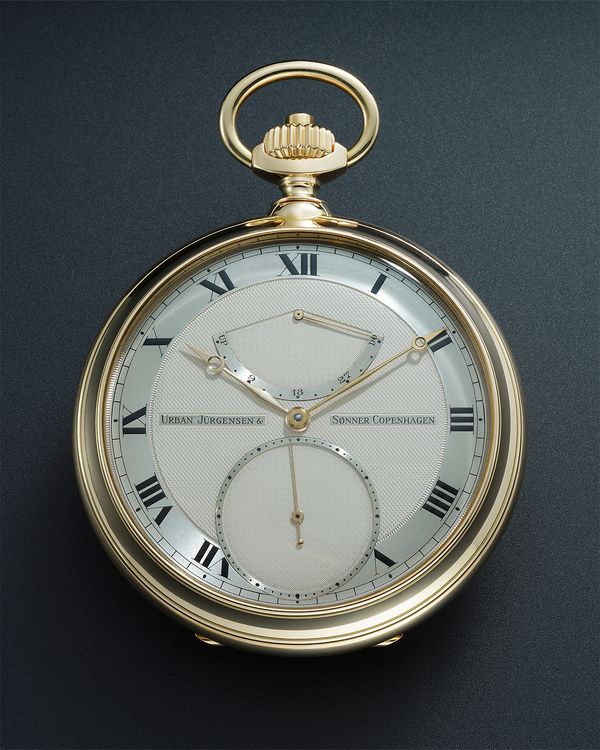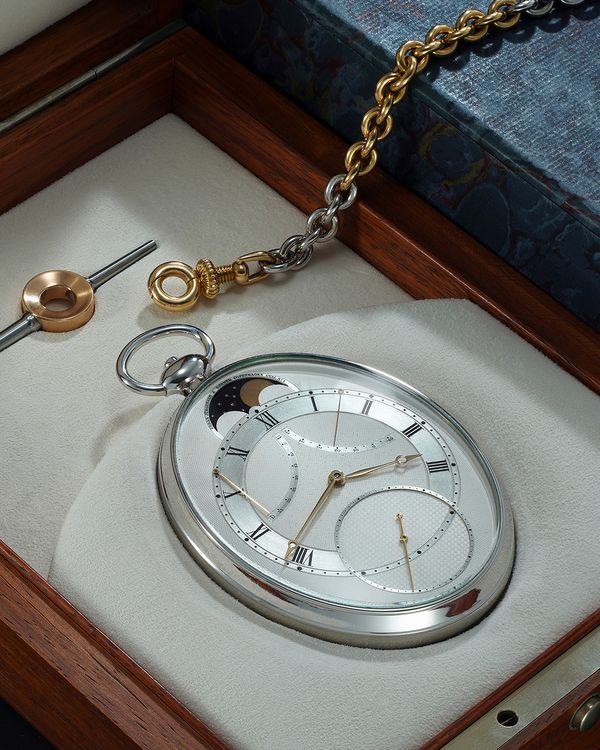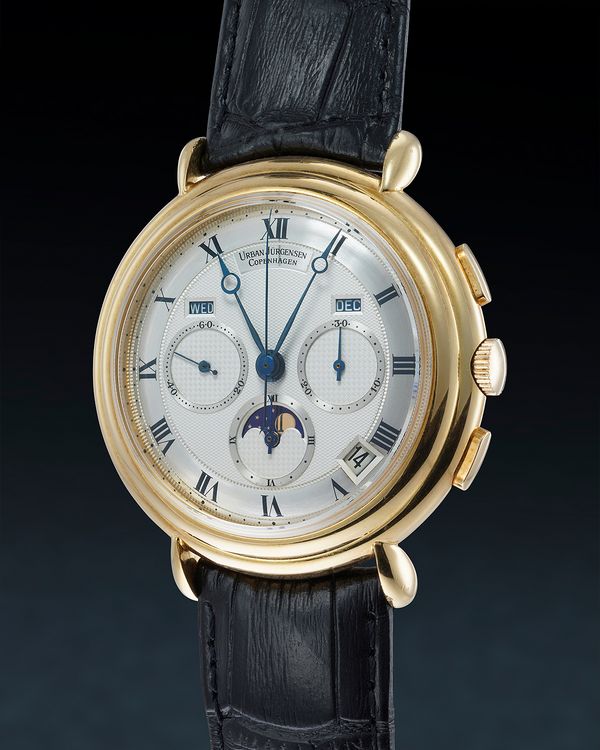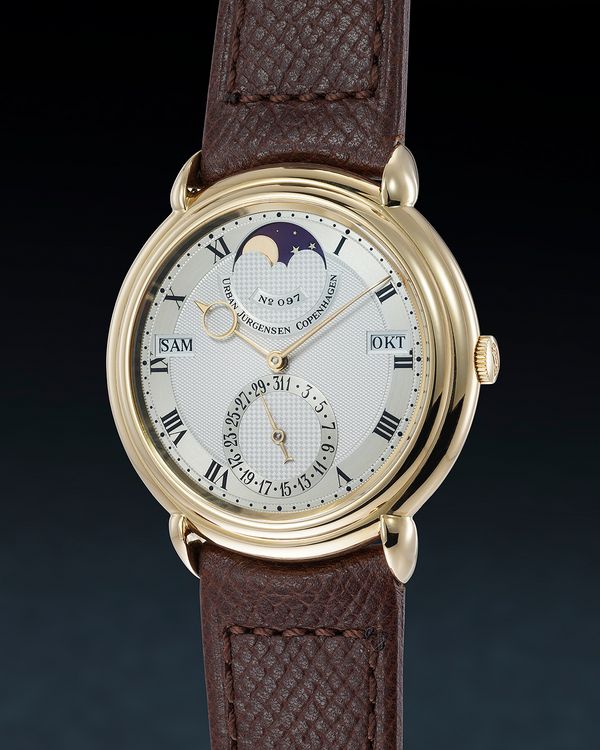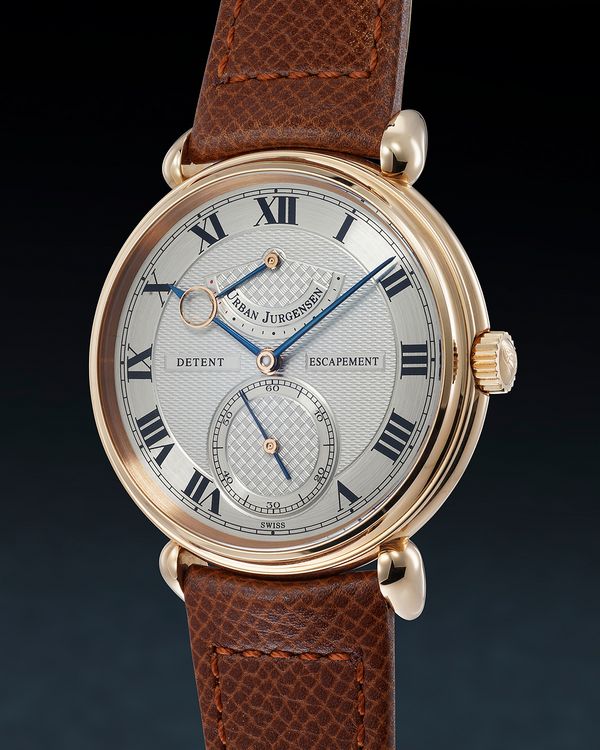To commemorate the 250th anniversary of Urban Jürgensen's founding, Phillips Watches is delighted to take part in a special exhibition. As part of our Geneva Watch Auction: XVIII preview, in Geneva, from 1 to 4 November, we will also host a non-selling exhibition dedicated to Urban Jürgensen, featuring approximately 25 of the firm's most significant and noteworthy timepieces, including the remarkable Oval Tourbillon pocket watch. These exceptional watches are taken from the private collection of Dr. Helmut Crott, highlighted in the following catalogue.
Celebrating 250 years of Jürgensen: A Digital Catalogue
– Text by Dr. Helmut Crott; Edited by Logan Baker
– Interviews filmed by Arthur Touchais; Featuring Dr. Helmut Crott and Arthur Touchot
The Jürgensen watchmaking dynasty celebrates its 250th anniversary this year.
I witnessed the rebuilding, relaunch, and then the marketing of new products at Urban Jürgensen & Sönner from the beginning in the modern era, including the ambitious undertaking started by Peter Baumberger in 2003 of developing an in-house movement, with the support of Derek Pratt, later joined by Jean François Mojon and Kari Voutilainen.
Things turned tragic when Peter Baumberger died, unexpectedly, in May 2010, at the age of 70. It was a sad and difficult situation, resulting in my acquisition of the Urban Jürgensen company. From the day Peter Baumberger left us, I settled in the Urban Jürgensen workshop in Biel, not to leave until I placed the brand in good hands. In the end it took five years, a fantastic challenge, but everything worked out well. My successors have continued the brand with respect and great commitment, and today I am happy and proud that Kari Voutilainen has taken on the lead of the Urban Jürgensen company.
I'm pleased to share a few details I've learned about the history of the Jürgensen family over my past few decades of connoisseurship.
The First Generation
It begins in 1745 with the birth of Jørgen Jørgensen, the forefather of the Jürgensen dynasty, a family who, over four generations, broke up the encrusted guild structure of craftsmen in Denmark by applying new theoretical and practical working methods. The Jürgensen family has achieved the highest recognition in watchmaking, as well as great prosperity and reputation in Denmark and Switzerland.
In the spring of 1766, Jørgen left Copenhagen for Germany where he pursued an apprenticeship as a journeyman watchmaker for six years. It was in this period that Jørgen changed his name to Jürgen Jürgensen, a more conventional German spelling.
Eventually, Jürgensen traveled to Le Locle, Switzerland, where he had the privilege of working with Jacques-Frédéric Houriet, a well-known and important watchmaker. Houriet had founded a watchmaking business of considerable importance and was a great promoter of the emerging industrialization of watchmaking. All this, of course, was of greatest interest to Jürgensen, who learned new manufacturing methods and how to achieve a high standard of quality in his work.
In April 1773, one year after his return to Copenhagen, Jürgensen applied to the watchmakers’ guild for permission to make a repeating watch as his masterpiece. He had created the necessary drawings and was referred to a watchmaker named Isaac Larpent for a joint execution of the watch. The two men already knew each other, and the situation brought them closer to the idea of founding a watchmaking industry in Denmark.
It was only eight years later, in 1781, that Jürgen Jürgensen finally received, in his name alone, authorization to establish a watch factory, creating new timepieces sold under the name Larpent & Jürgensen. Larpent & Jürgensen-signed watches date between 1773 and 1814, where about 4,000 examples were produced.
Jürgen Jürgensen's marriage to Anne Leth Bruun produced numerous children, including Urban, born 5 August 1776, and Frederik, born 19 August 1787, who followed their father professionally as watchmakers. Jürgen Jürgensen earned the merit of being the first individual to successfully introduce pocket watch manufacturing to Denmark, using the most modern methods of the time. According to church registers, he died on 16 April 1811.
Second Generation
Urban Jürgensen was born 5 August 1776 in Copenhagen, he was the eldest son of Jürgen Jürgensen and is the most famous of the four generations of the Jürgensen family watchmaking dynasty; in fact, the most important Danish watchmaker of all time.
Urban Jürgensen’s theory and practice of precision watchmaking was based on scientific principles, setting him apart from most of his colleagues at home and abroad. His methodology enabled him to competitively produce marine chronometers in Denmark, despite overwhelming international competition. When sent on his first trip abroad in 1797, at the age of 21, his education facilitated him entrance into famous watchmaking workshops in London and Paris.
Urban’s first stop was Le Locle, to work with his father's watchmaker friend, Jacques-Frédéric Houriet. Urban then traveled to receive horological training directly from the most famous watchmakers of the time, including Abraham-Louis Breguet and Ferdinand Berthoud, in Paris, followed by a rotation at the ateliers of John Roger Arnold and of John Brockbank, in London.
In 1801, Urban returned to Le Locle, where he married Sophie Henriette, Houriet’s daughter. He soon prepared for his return journey to Copenhagen, sourcing and importing a few proper machines meant for manufacturing precision clocks and watches from Switzerland to his home country.
Expectations at home were enormous. Urban published a general-use watchmaking textbook in December 1804, which quickly become a standard work for Danish watchmakers. That same month, he received a silver medal from the Royal Danish Academy of Sciences for his treatise on the manufacture of steel springs with machines and their subsequent hardening. Urban was again honored in 1805 with a gold medal from the Royal Danish Agricultural Society for his famous bimetallic pocket thermometers.
Urban returned to Switzerland in 1807 to visit his father-in-law, where he stayed for two-and-a-half years, working on the creation of different machines, which were needed to modernize his father's workshop. He eventually returned to Denmark with three trained, government-financed Swiss watchmakers. Despite his busy work schedule, Urban presented his first marine chronometer in 1811.
In the spring of 1811, Urban founded his own business in Copenhagen that expanded production. He quickly achieved a breakthrough in the serial production of marine chronometers and astronomical pendulum clocks. In addition to scientific clocks, fine consumer pocket watches were also produced, mainly due to the demand from travelers, especially the burgeoning American market.
Urban endured numerous tragedies throughout his life. He lost five of his eight children at a young age. When he died at the height of his fame on 14 May 1830, after a long illness, only three of his sons were still alive: the two watchmakers, Louis Urban and Jules Frederik, and the youngest, Frederik, known as “Fritz, The Colonel.” All three would later be associated with the company Urban Jürgensen & Sönner.
From 1800 until his death in 1830, Urban created more than 700 watches, 45 chronometers – mainly deck watches, as well as six precision pendulum clocks – plus many examples of his well-known bimetallic pocket thermometers. From 1811, he signed the watches with his own name. The watches were consistently signed on the dial but not always on the movement. Under the dial we often find “UJ” stamped with the movement number. However, since Urban was not always consistent when assigning serial numbers, it’s difficult to know what the exact production total was.
Jürgen Jürgensen’s fifth child, Frederik, was born on 19 August 1787 in Copenhagen. Despite his great talent, he remained in the shadow of his famous brother. In 1801, he became Urban's first apprentice, and at the age of 20, in 1807, he left Denmark for an international study trip.
While in Switzerland in 1811, he learned of his father's death and was called home to help continue his father’s business. That same year, Frederik was appointed as a court horologist and married Vilhelmine Rebecca Dichman, with whom he had a daughter, Sophie, and a son, Georg Urban Frederik, also known as Fritz. The company's name was changed to Frederik Jürgensen that year.
The fact that Frederik’s watches were often not numbered makes determining a production total difficult. One assumption is that Frederik made only 500 watches in the period between 1811 and his death in 1843, from which we can conclude the factory production never functioned as well as it did under his father's leadership.
Third Generation
When Urban Jürgensen died in 1830, his three surviving sons were 24, 22 and 13 years old.
Louis Urban, the eldest, trained as a watchmaker at his father's company from 1822 to 1828. He later embarked on an international study trip to renowned workshops in Paris, London, Liverpool, Geneva, and Le Locle. Louis Urban returned home in February 1834, and in June 1835, he married Annette Birgitte Leth Horstmann. They had only one child, Urban August Jürgensen.
Earlier, in 1830, Louis Urban and his brother, Jules Frederik, took over the family business and renamed it Urban Jürgensen & Sønner. Louis Urban became the sole owner in 1835, managing the Copenhagen business, while Jules moved permanently to Switzerland.
Louis Urban was less interested in day-to-day business than he was in the higher art of watchmaking. In contrast with his brother Jules’ work in Switzerland, who ran a factory with over 80 employees, Louis Urban employed only two journeymen and a single apprentice.
Louis Urban's son completed a six-year apprenticeship in his father's workshop, and, like his ancestors, Urban August received a state-funded scholarship for an international study trip. His talent rightly provided hope for a fourth generation of high watchmaking in the Jürgensen family. Unfortunately, fate had a different plan. Urban August died suddenly in 1866, at the age of 28; his father followed the following summer, at the age of 61.
It is interesting to note that Louis Urban Jürgensen's clocks and watches could be purchased via a pricelist, or, as of 1836, from a sales catalog. These were novelties at the time. Approximately 150 standard watches, from movement numbers 750 to 900, were built in Louis Urban’s workshop over a period of more than three decades. In addition, approximately 40 unfinished watches from his father's workshop were completed after his death. Louis Urban also built 110 marine chronometers and a small number of luxury pocket chronometers.
After Louis Urban's death in July 1867, the Danish branch of Urban Jürgensen & Sønner was led by his widow, Anette, and his younger brother Frederik, known as Fritz, The Colonel. Born in 1816, Fritz, unlike his brother Jules, was not a trained watchmaker; instead, he had a remarkable career in the military starting at just 12 years old.
Fritz remained be in close contact with his brother Jules Frederik throughout his life. According to a January 1866 letter, Fritz was granted general power of attorney to act under the name of Jules Jürgensen in Denmark. Fritz managed Urban Jürgensen & Sønner for over 20 years. When Anette died in January 1886, Fritz was given the task of sorting out the family estate. He found a suitable successor in Louis Urban’s trusted shop foreman, the horologist Heinrich E. Kiens.
When he took over the business, Heinrich Kiens renamed the firm Urban Jürgensen & Sønner Eftf (successor). The main business remained on Gothersgade, in Copenhagen, to handle the trade and repair of high-quality clocks. When Kiens died in 1898, his widow continued to run the business until their son, Carl, took over in 1911.
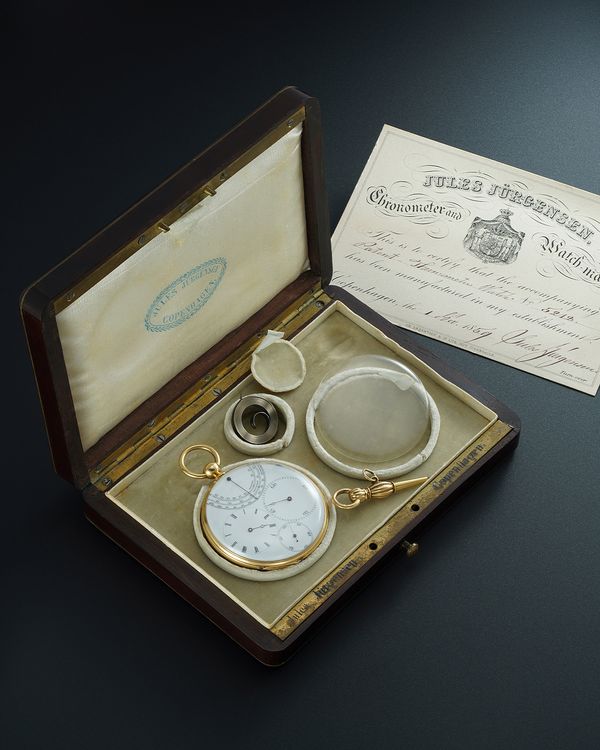
In 1932, the company was sold to a man named E. Bjerring. Fourteen years later, Randrup Jensen, a future chairman of the watchmakers' guild, acquired the firm. In 1955, Jensen’s journeyman, Christian Gundesen, took over the business for 22 years. Gundesen was committed to running it in the grand tradition of the Urban Jürgensen name. In 1977, the then-chairman of the watchmakers' guild, Gerhard Scheufens, took over the shop, setting up a small museum with historic clocks, tools, designs, and archives.
Since the death of Louis Urban Jürgensen, there have been no watchmakers of distinction in the Danish lineage of the Jürgensen family. Nevertheless, the Urban Jürgensen & Sønner brand has survived to date, confirming the historical importance of this Danish dynasty.
The third son of Urban Jürgensen, Jules Frederik, generally called Jules (I), was born in Copenhagen on 27 July 1808. Jules completed a watchmaking apprenticeship in his father's business and took over the management of Urban Jürgensen & Sønner at the age of 23. Jules eventually left Copenhagen in 1834 for his own watch study journey. He visited London, Liverpool, Birmingham, Paris, and Geneva, before finally settling in Le Locle to study under his uncle Jules Houriet, who had taken over his father's illustrious watchmaking atelier.
From the beginning, Jules was interested in developing a new type of pocket watch – one that was flatter, more elegant, and more complicated than ever before, but was still just as precise. Production according to these new principles quickly took off. Demand came from English and American customers visiting Paris, where Jules Jürgensen had set up a depot and salesroom. He was to become, in the commercial sense, the most successful off all Jürgensen watchmakers.
Fourth Generation
Jules married Anastasia Lavalette in October 1835. They had five children, including two sons, Jules Frédéric Urban (Jules II), born in 1837, and Jacques Alfred, born in 1842. In 1872, Jules I withdrew completely from his business in Le Locle, and on June 28, he signed the company over to his eldest son, Jules Frédéric (Jules II). Although gifted in theoretical and practical watchmaking, Jules II preferred to work on the business side of the industry. In the meantime, total production exceeded 15,000 watches. Jules (I) Jürgensen died on 17 December 1877.
In 1862, Jules II married Cécile Dubois. Their only child, Jules Philippe Frédéric, born in March 1864, will be the one family member to break the Jürgensen family watchmaking tradition. Jules II died in Le Locle, on 19 February 1894.
Jacques Alfred Jürgensen, the second son of Jules I, was born in Le Locle on 17 May 1842. He had an entrepreneurial spirit, setting up his own business, and in 1865, the “Jacques Alfred Jürgensen Locle” company was founded. The two Jürgensen companies operated closely together.
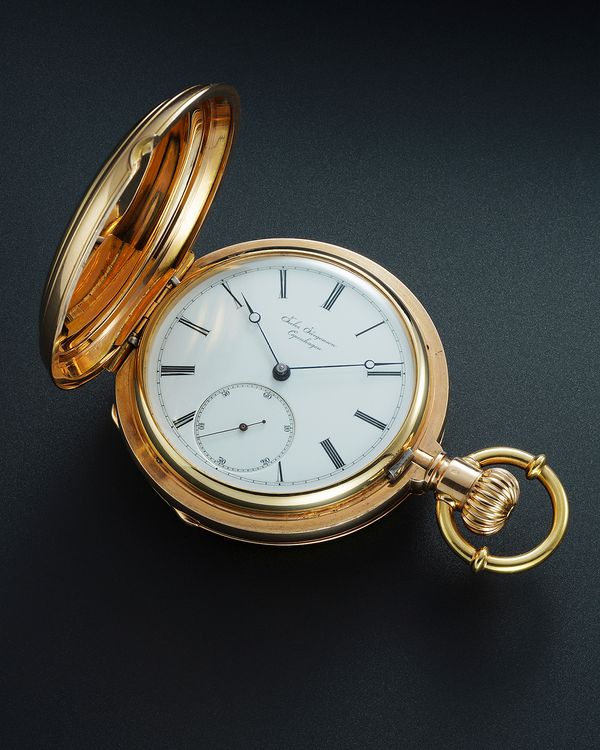
On the death of his brother Jules II in 1894, his only child, Jules Philippe Frédéric, inherited the factory and all the land. However, as he had no horological ambitions, his mother and Jacques Alfred had to manage the company and the inheritance. Jules Philippe Frédéric took his own life in tragic circumstances on 15 July 1897. This forced Jacques Alfred to buy out the company "Jules Jürgensen Copenhagen,” merging the two under the same name.
In the period between 1865 to 1896, Jacques Alfred only produced approximately 2,200 watches. He sold 356 of that total to Jules Jürgensen Copenhagen, and approximately 80 watches to Tiffany & Co., in New York.
The Successors
Jacques Alfred died on 30 June 1912. His widow was thus faced with the task of continuing the company alone; in fact, with no family heirs, the Jules Jürgensen Copenhagen Company in Le Locle was meeting the same fate as Urban Jürgensen & Sønner did, in 1891. It was a trusted former employee, David Golay, a one-time regulator, who later managed the business. He became the official owner of Jules Jürgensen in February 1917.
Henry Freund, an agent for Urban Jürgensen based in New York, and Charles Heuer, the son of the founder of Ed. Heuer & Co., in Biel, Switzerland, pushed for a takeover of the Jules Jürgensen brand in 1919. They succeeded, acquiring the rights to the Jules Jürgensen corporate identity and all its existing assets.
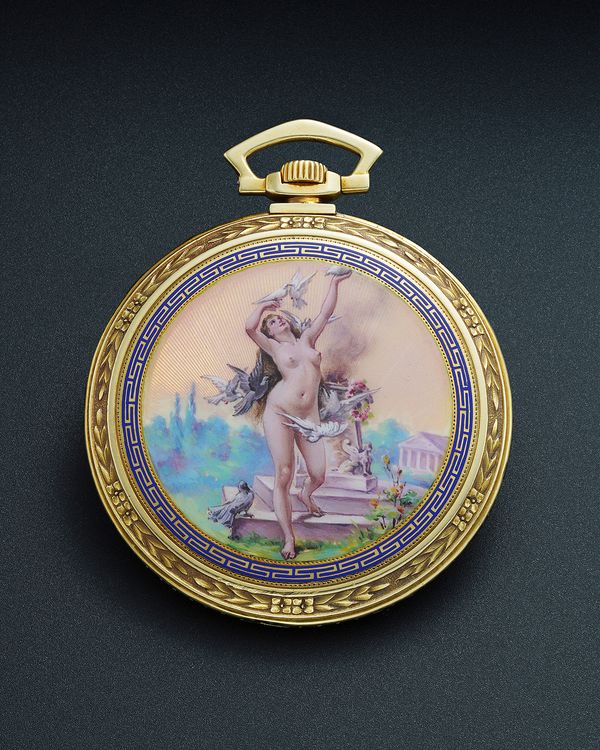
The 1929 stock market crash plunged the global economy into the Great Depression, which eventually led to the closure of the Biel factory, in 1932. Jules Jürgensen changed hands once again in December 1936 as an aftershock of the Great Depression. I believe this date signifies the end of any high-quality standard being associated with Jules Jürgensen watches.
The company moved to La Chaux-de-Fonds in 1953 after being acquired by an American organization. Ownership of Jules Jürgensen subsequently changed hands several more times until it was finally acquired by Morton Clayman, the owner of one Rhapsody Watch Company in Pennsylvania, in 1974.
Enter Peter Baumberger
Peter Baumberger was born in 1939, in Koppigen, Switzerland. He trained at the only Swiss-German Watchmaking School, in Solothurn, from 1955 to 1959. The Quartz Revolution was already looming in the foreground, and watchmaking jobs were hard to find once Peter graduated, so he ended up joining his father's company producing luminous dials. When a former watchmaking colleague, who had entered the antique clock trade, offered Peter a partnership in exchange for a small financial contribution, Baumberger was ready to get started on his new career.
A significant moment in Peter’s life came in 1976, during the 200th anniversary of the Danish Watchmakers' Guild. The then-owner of Urban Jürgensen, Christian Gundesen, had prepared a small exhibition of historic watches, tools, and documents in his shop window in Copenhagen. Peter, in those days, had the habit of regularly scouring the antique districts in the cities he visited.
At the sight of Urban Jürgensen's shop window in Copenhagen, Peter sensed his luck and stepped into the shop with aspiration and hope. With a casual outfit of jeans and T-shirt, he was eyed critically. To all enquiries about prices, he received the same answer: "Not for sale." His last attempt was for an Urban Jürgensen precision pendulum regulator, hanging on a wall. The answer was now different and a little gruff: "This clock is already reserved for an American collector who offered USD $45,000."
Slowly, however, the merchant began to take this unknown, prospective buyer – one that was asking for such expensive objects – more seriously. "How about you buy the whole place, then?” he quipped. This intriguing reaction, with the prospect of being able to acquire such a historically significant name, alongside the rare watches, would fundamentally change Peter’s professional and personal life. It appeared to be a remarkable opportunity.
Three years passed before Peter came any closer to his dream goal. In the meantime, Gundesen sold the shop to his nephew, Gerhard Scheufens. When Peter met with him for the first time, he was told in no uncertain terms that the name of this important Danish watchmaking dynasty was required to stay in Danish hands.
Peter thus had to persuade the new owner of Urban Jürgensen to sell the brand to a non-Dane. In addition to his powers of persuasion and his proverbial charm, Peter was also able to use his watchmaking expertise to convince Scheufens that he – and only he – could lead Urban Jürgensen to new glory. It was finally through a ruse that Peter was able to break the ice once and for all.
An English watchmaker named Derek Pratt that Peter was sponsoring had been working on his own movement at the time for the past five years. In 1979, Peter took Pratt’s first completed example and showed it to Scheufens with the tempting request of signing said watch, “Urban Jürgensen & Sønner Copenhagen.” One can imagine Scheufens was impressed, and proud that nothing, in principle, stood any further in the way of transferring the trademark rights to Peter.
The first part of Peter and Derek’s business plan was to create a small production series of pocket watch tourbillons. To do this, they needed to find an extremely well-equipped workshop – and a few specific antique machines. Peter sold his personal collection of important historic watches to finance their goals. One stroke of luck came from their timing. More and more Swiss Jura watchmaking companies were being liquidated every year due to the Quartz Revolution. The entire stocks of countless watch factories were placed on the side of the road for sale where they could be purchased for small sums of money. Peter selected the best machines and was able to quickly set up a new atelier for Urban Jürgensen and Derek Pratt.
250 Years of Urban Jürgensen : The Age of Independence (Ep. 3)
While Derek took care of movement construction and the production of dials and hands, Peter adopted the task of casemaking, as well as all branding and marketing activities. Today, the cases made by Peter bear “3000” serial numbers, with the highest currently known being 3068.
The quality of Peter and Derek’s first run of pocket watches set a high standard for their eventual series of wristwatches, which was finally realized with the ref. 1, featuring calendar, moon phase, chronograph, and automatic winding, in a limited run of 186 examples produced between 1982 and 1986. With heavy cases and soldered teardrop shaped lugs – not to mention the complex two-tone, frosted, hand-engine turned dials and delicate hands – Peter had created a modern image for Urban Jürgensen, which is now considered the DNA of the contemporary brand.
Urban Jürgensen then launched the ref. 2 in 1986, consisting of 50 platinum and 172 gold wristwatches with perpetual calendar, moon phase, and the upgraded Frederic Piguet No 71 automatic movements. The ref. 3 was introduced in 1993 as the natural successor to the ref. 2. The difference lies in the addition of a power reserve complication. Although, at first glance, this addition does not appear overly complex, its development took Peter and Derek much more time than expected, becoming considerably more expensive in the process, leading to financial difficulties for the reborn Urban Jürgensen brand for the very first time. Other variants of the ref. 2 include the ref. 9 with sub-dial displays, and the ref. 10 with small seconds; less than a handful of the latter may have been made. The ref. 4 had a two time-zone indication at 12 o’clock and was likely a unique piece.
Entry-level two- and three-handed models were produced as the ref. 5, ref. 8 and ref. Big 8, which had the upgraded Frederic Piguet caliber 1150 and 1160. The little-known ref. 6 had a tonneau-shaped case with a different caliber; this model likely never progressed beyond the prototype stage. One especially unusual model – likely a custom order – is the ref. 7, the so-called Diaplago, featuring a Dali-like case and a bracelet set with diamonds. A total of 11 individual wristwatch references were created before Peter passed away in May 2010.
As a matter of prestige, it appeared increasingly important for a premium brand to develop its own caliber. Peter and I often discussed this. He was very good at keeping company secrets, even to his closest confidants, but as my financial involvement in the company had taken on considerable proportions, he eventually let me in on the P8 and P4 project in 2008; these were in-house movements he had hidden from me for five years.
Peter didn't want to develop any in-house caliber, but one that would continue in the great tradition of Urban Jürgensen. In other words: precision timepieces with chronometer escapements. As early as 2003, Derek Pratt had prepared a feasibility study for the so-called P8 project, installing a chronometer escapement in a Unitas caliber as a test example. The result was encouraging; however, the challenges were manifold. In addition to miniaturization, the main issue was the escapement’s sensitivity to shocks, which was exacerbated in an always moving wristwatch.
Derek Pratt had successfully built a single one-off piece. However, serial production was the aim, and the challenge called for advanced horological engineering. So, the development was eventually placed in the hands of a young engineer named Jean-François Mojon, best known today as the owner of Chronode.
The goal was to create a multifunctional caliber that could host various complications and could be equipped with two different types of escapements, e.g., the P8 caliber should have a chronometer escapement and the P4 caliber, a lever. Derek gradually withdrew from the project for health reasons, so the independent watchmaker Kari Voutilainen took over his role, which was to carry out the decoration, assembly, control, and regulation of the movement, and then to provide feedback to Mojon and his engineers.
Finally, in December 2008, Urban Jürgensen was granted two separate patents for a new chronometer escapement that could be placed inside a wristwatch. Peter had already prepared the press kit for Basel 2010, all that was missing were the media invitations, as well as a worthy location at the fair to present this first-of-its-kind achievement.
At the last moment, we ended up cancelling the presentation of the new caliber during that year’s Baselworld. It was a difficult decision and certainly very bitter for Peter. It’s even more tragic in retrospect, as Peter died unexpectedly two months after the fair’s conclusion.
I went to our atelier in Biel immediately after the sad news was released and told everyone that I would honor all the commitments our company had made. It was important that all our suppliers understood that our brand would continue without any disruption to the old tradition and quality.
When I became responsible for the Urban Jürgensen brand in 2011, I had the immediate and fervent desire to see the two brands, Jules and Urban, reunited once again. It was a serious challenge, but finally – after more than 100 years apart – the Jürgensen watchmaking companies were reunited under the same corporate structure.
About Phillips In Association With Bacs & Russo
The team of specialists at PHILLIPS Watches is dedicated to an uncompromised approach to quality, transparency, and client service. Phillips in Association with Bacs & Russo holds the world record for the most successful watch auction, with its Geneva Watch Auction: XIV having realized $74.5 million in 2021. Over the course of 2021 and 2022, the company sold 100% of the watches offered, a first in the industry, resulting in the highest annual total in history across all the auction houses at $227 million.
Recommended Reading
Specialists' Picks: The Geneva Watch Auction: XVIII
From Derek Pratt To Kari Voutilainen: Four Watches That Represent Urban Jürgensen's Modern History
Naissance d'une Montre II: Meeting The Project's Collaborators, Part 1 (VIDEO)
